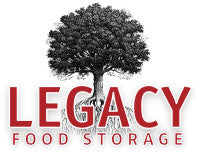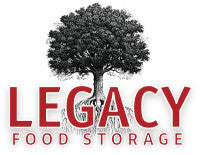
10 BRUTAL Truths about Prepping and Survival
Our approach at Legacy has always been education over fear. We don't believe in scaring people into buying products, but good planning requires understanding some uncomfortable realities. These insights come from studying real emergencies and how they really can unfold rather than how we might wish they would. Some of these truths might be surprising. But understanding them helps you make better preparedness decisions, avoid common planning mistakes, and build the kind of security that actually protects your family when a crisis happens.
1. Plan as if no one is coming.
When everyone needs help simultaneously in a disaster or crisis event, emergency services can collapse, leaving you to fend for yourself.
Disasters like Hurricane Katrina or other large-scale events, emergency calls went unanswered for days. Police and fire departments were overwhelmed, understaffed, and often victims themselves. They won’t be coming when they need help too. This reality becomes even more stark in widespread events like pandemics, grid failures, or natural disasters that affect entire regions.
Emergency responders have families to protect first, limited resources, and no obligation to risk their lives for yours when the system breaks down completely. FEMA and the Red Cross even recommend individuals plan to survive on their own for at least 72 hours.
TIP: Build practical skills and store supplies to handle emergencies without power or outside help.
2. Even your nicest neighbor can become a threat when starving.
Hunger trumps social bonds, moral codes, and rational thinking, transforming ordinary people into desperate survivors who'll do anything to feed themselves and their families.
History repeatedly shows that civilized behavior evaporates quickly when basic needs aren't met. During the 1992 Los Angeles riots, neighbors turned on neighbors within hours. In Venezuela's economic collapse, formerly peaceful communities saw armed home invasions become routine as people fought over food.
Your friendly neighbor who borrows your lawnmower today will break into your home tomorrow if his children have not eaten in days. Desperation doesn't discriminate based on previous relationships or social standing.
TIP: Store supplies quietly and not in plain sight.
3. Without documentation, your property, rights, and claims mean absolutely nothing.
In crisis situations, official records become the only recognized proof of ownership and rights, rendering verbal agreements and assumed logical understandings completely worthless.
When Hurricane Sandy destroyed countless homes, insurance companies and FEMA required extensive documentation before releasing funds. Homeowners who lost their paperwork in the storm faced months or years of legal battles to prove they owned their own property.
After wildfires, entire neighborhoods of people who "knew" their property lines found themselves in court battles because surveys and deeds were destroyed. In a crisis, your word means nothing - only official documents carry weight with authorities, insurance companies, and legal systems.
TIP: Store physical and digital copies (cloud storage or encrypted drives) of all legal documents in fireproof, waterproof storage.
4. Dehydration kills fast.
Your body shuts down in 72 hours without water. Period. Your mental toughness and six-pack abs won't negotiate with organ failure.
The human body is roughly 60% water, and every critical function depends on maintaining that balance. After just 24 hours without water, your cognitive function begins declining. By 48 hours, exactly when you need sharp decision-making most, you can experience severe headaches, dizziness, and impaired judgment. At 72 hours, your kidneys start shutting down regardless of how mentally tough you think you are. No amount of military training, meditation, or physical conditioning changes this. Water is truly life.
TIP: Store as much water as you can and have a back-up filter to clean more.
5. Listening to the wrong person can get you hurt or killed.
Popular survival advice is often dead wrong, literally. Bad information can kill faster than no information. We can’t stress enough, do your own research. Most advice is from people who've never faced real danger. This is especially relevant in the age of social media. Inaccurate advice about food preservation, foraging, or water purification can be fatal.
Social media is flooded with survival "experts" who've never spent a night outdoors without a hotel nearby. Following bad medical advice, faulty shelter techniques, or dangerous water purification methods can turn a survivable situation into a fatal one. The internet rewards engaging content over accurate information, meaning the most popular advice can be the most dangerous. Always verify sources and prioritize information from people with documented real-world experience over viral or popular content creators.
TIP: Research multiple sources and prioritize advice from those with real experience.
6. Gear is worthless if you don't have the skills to use it.
The most expensive survival equipment can become useless without regular refreshers and genuine competence. Military and bushcraft professionals repeatedly emphasize hands-on practice and muscle memory. Owning a $500 water filter doesn't help if you've never assembled it under stress or parts are missing. Having a $5,000 generator is meaningless if you don't know how to operate it or use it.
During emergencies, fine motor skills deteriorate due to stress and adrenaline, making even simple tasks more difficult. Equipment that seems foolproof in your living room, or demonstrated at the store becomes impossibly complex when you're cold, scared, and operating in the dark.
Got a bunch of free gear thrown in with your emergency food purchase? Chances are it is lower quality which makes testing and practice even more critical. Because if it was free or cheap, plan on it failing when you need it most.Better to know during a test, so you know to upgrade. Regular practice is the difference between life-saving tools and expensive paperweights.
TIP: Test your plans and gear regularly under realistic conditions - stress, cold, darkness, and fatigue.
7. Your physical fitness level can determine if you are a casualty waiting to happen.
Physical capabilities directly determine your ability to escape danger quickly, carry essential supplies, and withstand the intense physical demands of crisis situations.
When seconds count, your cardiovascular fitness determines whether you can run from danger or become a victim. If you can't carry a 40-pound pack for a mile, how will you evacuate with essential supplies on foot if cars are not an option? If climbing a single flight of stairs leaves you winded, how will you escape a multi-story building during an emergency?
Physical fitness is about having the strength to lift debris off trapped family members, the endurance to walk long distances when vehicles fail, and the agility to navigate dangerous terrain when normal routes are blocked.
TIP: Set a realistic fitness goal based on your age and abilities. Every improvement in strength and endurance could save your life.
8. Your food and water supplies will not last as long as you think.
Understand consumption rates skyrocket during emergencies due to stress, inefficiency, and unplanned needs, depleting even carefully calculated supplies much faster than anticipated.
Stress increases caloric needs by up to 30%, but most people calculate their food storage based on normal consumption, normal weather, and a cozy, safe home. Cold weather can double your caloric requirements. Physical exertion from emergency activities burns through supplies rapidly.
For perspective: A wildland firefighter burns 4,000-6,000 calories per day fighting fires and needs 6-10 liters of water daily. This is 2.5 gallons just to stay functional. Almost triple a normal person's needs. If you're doing emergency work like clearing debris, hiking with gear, or manual labor in a crisis, your food will disappear faster than your predicted calculations.
You'll also discover additional "hidden” needs for water with your emergency food, medical care, cleaning wounds, or sanitation.
Don’t count on all that food in your refrigerator or freezer lasting very long. Food spoilage occurs quickly without reliable refrigeration. Sharing with unprepared neighbors or family members who show up at your door can cut your supplies in half overnight. What you calculated to last a month might be gone in two weeks.
TIP: Build in a buffer for both food and water. Expect higher consumption, spoilage, and unexpected sharing. Ensure you have stock of shelf-stable food supplies and ways to secure safe water beyond your stored supply.
9. Your carefully crafted plans can fail.
No plan survives implementation because real emergencies involve countless unpredictable variables that theory and practice can never fully account for.
Your evacuation route might be blocked by fallen trees, flooding, or accidents. Your designated meeting place could be destroyed or occupied by others. Communication systems you planned to use might be overloaded or damaged. Family members might be separated when disaster strikes, making your coordinated response impossible. Weather conditions could be worse than anticipated. Critical supplies might be inaccessible or damaged. The specific emergency you face might combine multiple threats you never considered together.
A powerful way to develop this adaptability is through the OODA loop (Observe, Orient, Decide, Act), a proven decision-making cycle that keeps you ahead of chaos by continuously reassessing and acting in fast-changing conditions. Plans are essential, but flexibility and multiple contingencies are what keep you alive when Plan A fails. Adaptability is the cornerstone of good preparedness.
TIP: Plan for your Plan A to fail. Create multiple backup options, and practice adapting when none of them work.
10. You will spend money on things you may never use.
The financial investment in comprehensive readiness requires sacrificing immediate pleasures for protection against threats you desperately hope will never materialize.
Insurance for your home, car, and health costs thousands annually for protection you hope never to need. Readiness supplies work the same way. That generator sitting in your garage for five years without use still provided peace of mind during every storm. The medical supplies with expiration dates you had to replace cost money but ensured you'd be ready for emergencies that thankfully didn't happen.
Unlike insurance, which only pays out after an event, preparedness supplies require an upfront investment for threats that may never materialize. But just like those other insurances, it’s not waste, it’s the cost of security for your family in an uncertain world.
TIP: Build your preparedness in layers. Focus on essentials that handle multiple scenarios first, before investing in specialized gear you may never need.
Final Thought: True family security comes from understanding these harsh realities, developing practical skills, and building the mental flexibility to adapt when your best-laid plans fall apart. This is the difference between saying you’re prepared and truly being ready.
Tags
- All
- 25 year food
- 25 year shelf life food
- 72 hour kit
- Best food storage types
- Best long-term food storage
- Blizzard preparedness
- Budgeting
- canning
- Certified GMO-free Emergency foods
- Certified GMO-free foods
- Coffee
- Comparison of emergency food methods
- Composting tips
- Dangers of genetically modified foods
- dehydrated food
- Edible Wild Plants
- emergcy preparedness
- Emergency Cooking
- Emergency Food
- Emergency food Christmas gifts
- emergency food storage
- Emergency Food Supply
- Emergency food supply recommendations
- Emergency Planning
- Emergency Preparedness
- Emergency preparedness advice
- emergency preparednesss
- Emergency Supplies
- Emergency supplies checklist
- Emergency Survival
- emergency survival gear
- Emergency survival kit checklist
- Emergency Survival skills
- exercise
- Family emergency preparedness
- Family emergency preparedness plan
- Family Preparedness
- Food Storage
- Food storage 25 year shelf life
- Food storage amounts
- Food storage Christmas
- Food storage containers long term
- Food Storage Secrets
- Food storage serving size
- Food storage types compared
- freeze dried food
- Freeze dried food storage
- freeze dried meats
- Freeze-dried emergency food storage
- Fruit Trees
- Gardening
- Getting Started
- Gluten-free food Storage
- Gourmet emergency food
- Healthy food storage
- How much emergency food to store
- Improved emergency preparedness
- Jared Markin
- Jared Matkin
- Legacy Premium
- Lessons learned from Hurricane Sandy
- Lessons learned from natural disasters
- long-term food storage
- Long-term Food Storage Guidelines
- Long-term Food Storage tips
- Long-term water storage
- Mental Emergency Preparedness
- Mental toughness
- Money-saving tips
- Natural disaster planning
- Natural Disasters
- Perfect Christmas gifts
- Pet Emergency preparedness checklist
- Pet Emergency preparedness kit
- Pet Emergency Survival tips
- Pets and Emergency Preparedness
- Plant Foraging
- portable solar panels
- portable solar power
- portable water filters
- protein drinks
- Risk of genetic modification
- Seed saving and storage
- Seed saving guide
- Self-reliance
- Self-reliant practices
- Shelf Life
- Solar Cooking
- Solar Ovens
- Special Dietary needs
- Stranded in a car in a blizzard
- Survival food
- Survival Gear
- survival kit
- Survival kits
- Survival Ovens
- Survival Skills
- survivalist gear
- suvival kit
- Tree Pruning tips
- Tree Trimming basics
- unique ideas
- water bottle with filter
- water filter
- water filter straw
- water filters
- Water Filtration
- water pitcher with filter
- water pitchers with filters
- Water purification
- Wild Food Foraging
- Winter composting
- Winter driving
- Winter preparedness tips
- Winter storm preparedness tips
- Winter Survival







